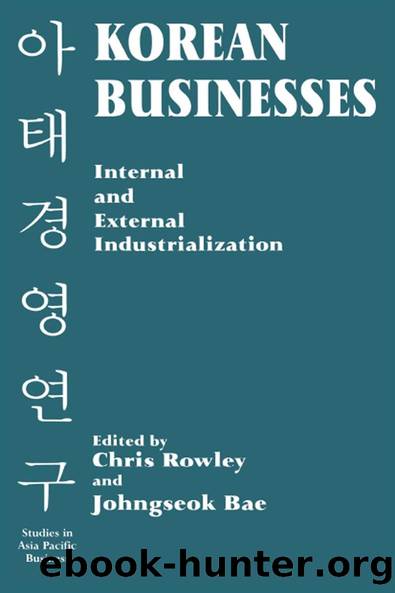Managing Korean Business: Organization, Culture, Human Resources and Change by Chris Rowley & Johngseok Bae & Tae-Won Sohn

Author:Chris Rowley & Johngseok Bae & Tae-Won Sohn [Rowley, Chris & Bae, Johngseok & Sohn, Tae-Won]
Language: eng
Format: epub
ISBN: 9780714652399
Goodreads: 7936736
Publisher: Routledge
Published: 2001-11-01T00:00:00+00:00
1960s/70s OEM
Learns assembly processes for standard simple goods
Foreign TNC/buyer designs, brandsand distributes
Mid-1980s ODM
Local firm designs;* learns product/process innovation skills
TNC buys, brands and distributes; TNC gains PPVA**
1980s/Mid-90s OBM
Local firm designs and conducts R&D for complex products
Local firm organizes distirbution, brand name, and captures PPVA
* Latecomer contributes to the design alone, or in partnership with the foreign company.
** Post-production value added.
Table 6 indicates the progression of latecomers from OEM, to ODM to OBM.22 Early latecomer entrants began with OEM because they lacked their own marketing capabilities and brand names.23 By the early 1990s, the chaebol and most larger Taiwanese companies had established OBM in at least some areas, though most still depended on OEM/ODM for much of their exports. The linear progression suggested in Table 6 need not occur, nor is there any automatic progress for companies. R&D may begin fairly early on and there may be feedback between early and later stages. Early entrants will tend to begin with simple tasks and develop skills and knowledge in a path-dependent cumulative manner. However, later entrants, such as ACER, may âjump inâ at more advanced levels, missing out the early stages. As the absorptive capacity of the economy increases, new startups bypass earlier phases. Spin-offs from older firms and other sectors, as well as new start-ups, constitute the growing industrial base.
Most firms have yet to reach the innovation frontier (defined as the point at which substantial R&D is required to generate new products or processes). This is a moving frontier occupied by world leaders at any given time. However, by the early 1990s, some latecomers reached the frontier in at least some product lines. As in the case of SEC in DRAMs, substantial investments in R&D are then required to compete on the international stage. At the frontier, R&D becomes an early and central part of the innovation process and more traditional leader and follower dynamics begin (Utterback and Abernathy, 1975; Abernathy et al., 1983; Utterback and Suarez, 1993).
Download
This site does not store any files on its server. We only index and link to content provided by other sites. Please contact the content providers to delete copyright contents if any and email us, we'll remove relevant links or contents immediately.
Spell It Out by David Crystal(36016)
Life for Me Ain't Been No Crystal Stair by Susan Sheehan(35713)
Cecilia; Or, Memoirs of an Heiress — Volume 1 by Fanny Burney(32396)
Cecilia; Or, Memoirs of an Heiress — Volume 3 by Fanny Burney(31788)
Cecilia; Or, Memoirs of an Heiress — Volume 2 by Fanny Burney(31758)
The Great Music City by Andrea Baker(31231)
Professional Troublemaker by Luvvie Ajayi Jones(29564)
We're Going to Need More Wine by Gabrielle Union(18930)
The Secret History by Donna Tartt(18793)
Twilight of the Idols With the Antichrist and Ecce Homo by Friedrich Nietzsche(18472)
All the Missing Girls by Megan Miranda(15453)
Cat's cradle by Kurt Vonnegut(15128)
Pimp by Iceberg Slim(14274)
Bombshells: Glamour Girls of a Lifetime by Sullivan Steve(13944)
Talking to Strangers by Malcolm Gladwell(13163)
Norse Mythology by Gaiman Neil(13158)
Fifty Shades Freed by E L James(13140)
For the Love of Europe by Rick Steves(12490)
The Social Justice Warrior Handbook by Lisa De Pasquale(12104)
